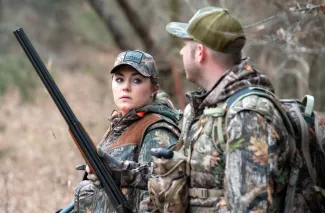
Squirrel and rabbit seasons capture the very best of the outdoors – glorious weather, good company and varied landscapes. In the small game woods, the most basic yet most important hunting skills are honed; skills like hunter safety, attention to detail, strategy, stealth, proper firearms handling and marksmanship. These are the building blocks of an effective, enjoyable hunting career that will pay dividends over time. And we're inviting hunters to (re)discover the benefits that small game hunting can bring to the outdoor experience.
In Oklahoma, fox squirrels can be found statewide, and the smaller gray squirrel can be found east of I-35. Generous harvest limits and a lengthy season afford you the opportunity to hunt squirrels in fruit trees in the spring and summer, and in the bare, leafless treetops during fall and winter. And don’t let anyone tell you that squirrel meat isn’t fit for the chef’s kitchen.
There are also three species of rabbits in Oklahoma; the cottontail, swamp rabbit, and jackrabbit. All three are available to hunt and provide excellent meat for the table.
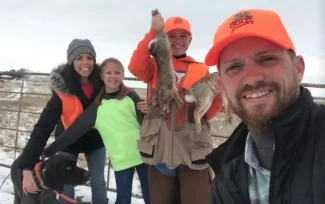
It's high time hunters are reminded of the benefits of squirrel and rabbit hunting in Oklahoma. Opportunities are widely available and accessible to both prospective and experienced hunters. You don't have to hike far into the woods or brush to find good habitat and game, yet the avid hiker can walk to their heart’s content in pursuit of new spots. With long seasons and liberal harvest limits, squirrel and rabbit seasons can accommodate even the busiest of life schedules. And there are numerous resources to help hunters gain an awareness and understanding of how to find game and be successful. In short, an exploration of small game hunting will challenge your assumptions about just how simple and easy it is to get outdoors for a few hours of good hunting in Oklahoma.
SPECIES PROFILE
- Oklahoma Distribution
Squirrel
The fox squirrel can be found across the majority of Oklahoma except the extreme west panhandle. Gray squirrels are somewhat more restricted in distribution and habitat preference in Oklahoma than the fox squirrel. The gray squirrel is found only east of the 97th meridian in mature bottomland forests, hardwood uplands, forested ridges, and oak-hickory-pine forests. Some think of "east of I-35" as a good general marker for where gray squirrels are more heavily populated.Rabbit
Cottontail are found statewide whereas swamp rabbits are found in central, northeast, and southeast Oklahoma. Black-tailed jackrabbits can be seen statewide, but they are most common in western Oklahoma.- Description
Squirrel
Oklahoma has two species of squirrels that are legal to hunt: the eastern fox squirrel and the eastern gray squirrel.
Image
Eastern Fox Squirrel / Photo by Bob Chance/RPS
The fox squirrel’s color is burnt orange or grizzled brown on the extremities with a gray back. The fox squirrel is larger than the gray squirrel, with a normal weight of one to three pounds.
Image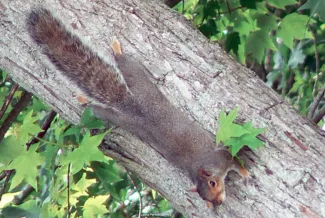
Photo by Laura Perlick/USFWS
The gray squirrel has gray fur on its back, white undersides and the edge of the tail is whitish.
Rabbit
Image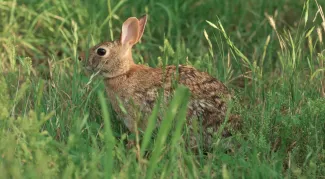
Eastern Cottontail / Photo by ODWC
The cottontail has soft brown hair and a white underbelly, and as its name suggests, a cotton ball-like tail. Similar to the whitetail deer, the cottontail will raise its tail like a warning flag when fleeing danger. Mostly ears and legs, an adult cottontail measures about 16 inches and weighs between two and three pounds.Image
Hunters and dogs with an Oklahoma swamp rabbit. Photo by Blake Podhajsky/ODWC
The swamp rabbit is larger in overall size than cottontails, with smaller and more rounded ears and coarser fur, with a more yellow cast. Its thick fur is dense enough to waterproof its skin and is usually a mix of dark brown, rusty brown, and black. Its throat and tail are white, and it has cinnamon-colored circles around its eyes. Swamp rabbits weigh between three and six pounds. Their total length varies from 16 to 22 inches, with males generally growing slightly larger than females.
Image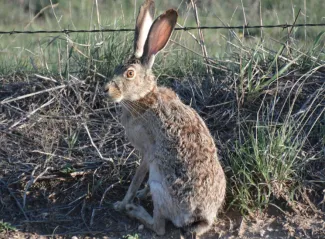
Photo by ODWC
The black-tailed jackrabbit, the only jackrabbit occurring in Oklahoma, is not really a rabbit but a hare. It has a buff gray body above, white below, and a black stripe down the center of its back. Its most distinguishable features are its black-tipped ears, which measure between five to seven inches in length, as well as its black-top tail.
- Habitat
Squirrel
Gray and fox squirrels require mid to late-succession forests (in Oklahoma, that means wooded areas that are more mature growth trees and other plants). However, they will forage in some early successional stages such as clearcuts, forest openings, or cropland. Both species can be found in bottomlands, on bluffs, and along rivers.
Gray squirrels prefer cavities in the trees to escape predators, for winter shelter and to raise their young. When cavities aren't available, they will also build a nest out of leaves and twigs high in a tree.
Fox squirrels are more likely than gray squirrels to use leaf nests in winter to raise their young. Leaf nests are usually built in trees with supporting grapevines. Fox squirrels need access to three or four trees with grapevines per acre, whereas grays need two or three.
Rabbit
Cottontail: Cottontails can be found in a variety of habitats, but are most abundant in open country. Rabbits will most often be found anywhere two types of cover meet, such as fence rows, or in tangled thickets in pastures or along roadsides. Rabbits also show a preference to areas not far from a water source whether it be a pond creek or spring. Cottontails rely on shrubs or woody vegetation for escape cover. The denser and thornier the cover is, the better the rabbit likes it. A rabbit's home range varies depending on the quality of its habitat. On average, a female cottontail's home range is five to 15 acres, while the male's may be as much as 100 acres.
Swamp Rabbit: Swamp rabbits are generally associated with bottomlands, floodplains, wooded swamps and marshes, estuaries and tributaries of rivers and streams, and canebrakes. The preferred habitat for the swamp rabbit is a system of low ridges, small sloughs, and marshes that are grass-dominated. Grain fields can also be used by the swamp rabbit in times of flooding as a source of food and cover. The swamp rabbit usually ranges no farther than about a mile-and-a-quarter from a major water source. Remnant stands of forested wetlands provide poor-quality habitat for swamp rabbits because flood waters often force the rabbits to use unsuitable upland cover.
Jackrabbit: Adapted to Oklahoma’s open landscapes, black-tailed jackrabbits live in low, brushy areas with vegetation that is typically less than three feet high. They live in a world in which 95 percent of the landscape is under this three-foot mark. Jackrabbits often prefer grazed pastures with a few shrubs or small trees. This habitat makes it easier to spot predators such as coyotes, foxes, badgers, bobcats, and red-tailed hawks, for which they are favorite prey.
- Natural Food Sources
Squirrel
In fall and winter, the major food source for both squirrel species is hard mast such as pecans, acorns, and hickory nuts. The mast produced by heavy-seeded tree species generally determines the carrying capacity for squirrels in a given area. As a result, squirrel populations often fluctuate with changes in hard mast yields.Because of the periodic nature of mast crops, a variety of alternate food sources must be present for more stable habitat conditions. Important soft mast-producing species include mulberry and blackberry. Maple, black gum, Osage orange, black cherry, and grape are also good food sources. Squirrels often ingest fruits, berries, bark, fungi, roots, bulbs, floral parts, and in some cases animal parts (insects, other invertebrates,
etc.).Rabbit
A rabbit will eat just about anything green, but use the most nutritious foods first, such as legumes clover and young forbs. A young rabbit will consume large amounts of grass and weeds like dandelions and ragweed. During the winter, when its normal food sources are scarce, rabbits will resort to eating shrubs and tree buds. Black-tailed jackrabbits eat twigs and bark of woody plants during fall and winter, and grasses and weeds during spring and summer. They get most of their water from succulent plants. Jackrabbits eat constantly and are particularly fond of alfalfa. In general, rabbits are most active during the early morning and late evening hours.
- Breeding
Squirrel
Both fox and gray squirrels can reproduce year-round, but most litters are born in the spring. After a gestation period of 42 days, a litter of three to five blind, hairless babies are born and the mother assumes all parenting roles until the young squirrels are able to fend for themselves at about three months of age.While in the nest, young squirrels are vulnerable to snakes and raccoons and once they grow up they are constantly on the lookout for other predators including foxes, bobcats, coyotes, hawks, and even owls. In urban areas, dogs, cats, and cars can also take their toll on squirrel populations.
Rabbit
Rabbits are quite prolific and may produce multiple litters in a year. With good weather and habitat, a female rabbit may produce six litters in a single year. Cottontails begin to court as early as February. A litter of four to seven bunnies is born after a gestation period of 27 days. The mother rabbit feeds her young milk twice a day at dawn and dusk.To protect the helpless, hairless bunnies from the cold, the mother builds a nest from the surrounding vegetation and the soft fur from her belly. She covers the young in the nest to keep them warm and dry when she goes out to feed.
All the members of a swamp rabbit population breed around the same time (which is called synchronous breeding). The breeding season typically falls between February and August. The females give birth to up to six offspring. They make nests of grasses and twigs in a depression on the ground under a brush pile or log.
Newborns' eyes open after four to seven days. Young leave the nest after about two weeks. Swamp rabbits reach sexual maturity after 23 weeks. Most females will have two to three litters per year. A female jackrabbit may bear three to four litters per year with up to eight young per litter. "Leverets," as they're called, reach adult size and are able to breed in about seven to eight months. Unlike true rabbits, whose young are born helpless and without fur, jackrabbit young are born fully furred with open eyes and can hop and leave the nest within a few hours after birth.
HUNTING TIPS
First Things First
Right from the start, you need to make sure you have a valid hunting license in hand, if applicable. Hunters “pay to play,” and with that everyone benefits – wildlife as well as hunters and non-hunters alike. In Oklahoma, hunters pay for conservation efforts through the purchase of hunting licenses, which the Wildlife Department uses for operations. Another way hunters pay is through their purchase of firearms and other sporting goods. Federal excise taxes on these purchases are paid by manufacturers and then distributed to state wildlife agencies based on the size and number of licensed hunters in each state.
In Oklahoma resident small game hunters 18 or older need a valid hunting license, which can be an annual, combination hunting and fishing, or lifetime hunting license. Get yours through your Go Outdoors Oklahoma online license account. Hunters under 18 do not need a hunting license to go squirrel or rabbit hunting.
When to Go
Squirrel
Squirrel season is one of if not the longest of the Oklahoma hunting seasons. Beginning May 15, and running through Feb. 28, it offers the flexibility to enjoy a hunt in Oklahoma's outdoors during your favorite time of year. A liberal limit of 25 fox and gray squirrels combined per day offers hunters additional flexibility. For example, you may want to make several trips throughout the year, taking only a couple of squirrels each trip. On the other hand, a combined daily bag limit of 25 fox and gray squirrels will allow you to stock the freezer even if you can only make one trip a year. And that’s perhaps our best tip - to make time for at least one squirrel hunt each year. Make it an annual thing!
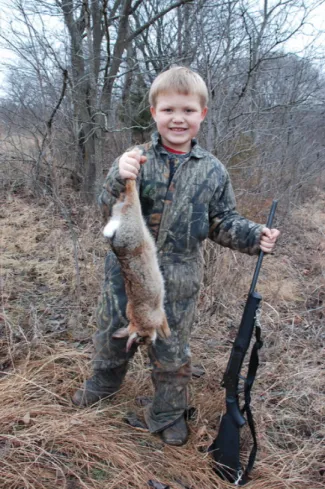
Rabbit
Rabbit season is a long-running opportunity as well, opening Oct. 1 and running through March 15, annually.
Be sure to consult the small game hunting regulations for complete details.
Where to Go
Access to places to hunt small game is plentiful. Whether hunting on private property or on the many wildlife management areas owned by the Oklahoma Department of Wildlife Conservation, you can find squirrels and rabbits almost anywhere in the state. However, seasons may vary on public areas, so if you're planning a trip to a WMA, consult the regulations for the specific area you intend to hunt. It’s easy!
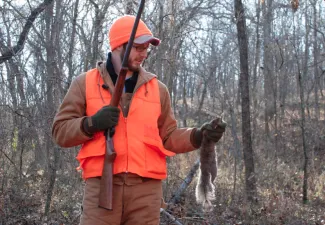
For starters, you can use our list of Wildlife Management Areas to locate where you might want to go. Start close to home, or if you're feeling adventurous, pick somewhere new! Select the area for a description, and you’ll also find a section on area-specific regulations that will tell you if squirrel or rabbit seasons have any specific things to know. In addition, you need to know the regulations for hunting both species.

You can also take advantage of the Oklahoma Land Access Program (OLAP). Administered by the Wildlife Department, OLAP provides financial incentives to landowners who allow public access for hunting, fishing, stream access, and wildlife viewing opportunities on private lands. That has resulted in a number of locations to hunt small game.
What to Wear
Small game hunting is simple and easy, but there are still some things to consider, such as proper attire. For squirrel or rabbit, tuck in shirttails and wear knee-high boots to reduce the number of areas where ticks and other insects can enter. If you don’t have knee-high boots, a comfortable pair of hiking shoes used for other outdoor activities is a good choice.
Both squirrel and rabbit seasons overlap with deer muzzleloader and gun seasons. During these periods, all hunters, including small game hunters, are required to wear either a blaze orange hat or blaze orange upper garment. Full hunter-orange requirements can be found in the regulations for hunting big game.
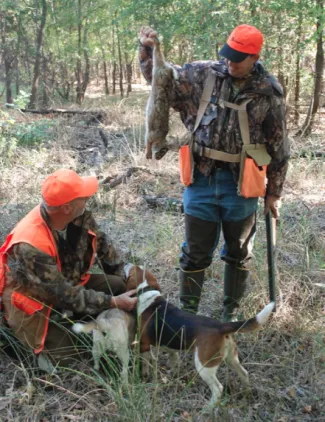
Squirrel
Wear camouflage clothing if you have it, but jeans and a dark T-shirt are all you really need. You may have to fine-tune your tactics while wearing blaze orange, but with a little practice, you can sit still enough to ambush a squirrel.
Rabbit
A pair of brush pants can be a lifesaver when walking through brush in rugged open country.
Gearing Up
A quick glance at the Oklahoma Fishing & Hunting Regulations shows there are many options for your method of take. A hunter may use anything from a “hand-propelled missile” (also known as a slingshot) to a variety of rifles, shotguns, or archery equipment. Don’t overlook any opportunity!
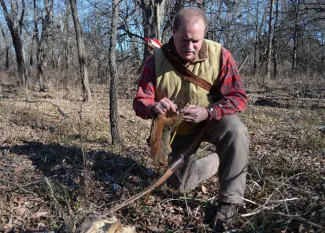
Most small game hunters prefer either a small gauge shotgun, with size 6 to 8 shot, or a .22-caliber rifle. If you choose a .22, you may wish to use one fitted with a scope. This is a nice option, but it isn't necessary. Hunters can become very proficient in shooting any rifle with open sights by spending time at the range (we’ve got those, too!), and shotgunners should spend time patterning their shotgun to determine effective ranges for clean kills.
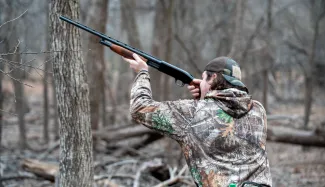
Safety is always important on the range and in the field. Many people do not realize it but a .22 caliber rifle bullet can travel more than a mile. Squirrel hunting usually involves shooting skyward, so always be aware of what is downrange. Watch for other hunters in your party and otherwise.
A small pair of binoculars fits in a pocket and can go a long way in identifying game. Look for body parts such as squirrel's bushy tail or a rabbit's ears. As always, fully identify your target before taking a shot.
Tactics
Squirrels
Quietly stalking through wooded habitat, stopping frequently to listen and watch, can be effective. It’s also effective to target a food source or likely habitat and simply sit down for a half hour or so, focusing on sounds and movements in the timber. In the springtime, locate a mulberry tree, and take a seat to watch. If you manage to harvest a squirrel, give it 10 minutes or so of sitting still, and you might locate others returning to activity after the disruption of your shot has cleared.
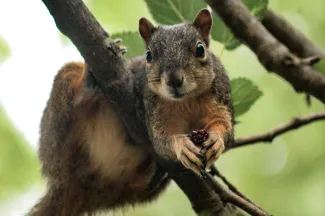
Avoid abrupt movement which can alarm squirrels into hiding. Keep your movements to a minimum. You can purchase squirrel calls that mimic the sounds squirrels make at different times of the year. These calls can help you locate squirrels or even draw them to you.
Rabbit
Much like upland bird hunting, you can jump rabbits by walking in open, brushy country, or other likely habitats.
For squirrels or rabbits, target habitats and food sources are listed in the species profile above. Both squirrels and rabbits can also be hunted with specially bred and raised hunting dogs. The hunters who keep these dogs are often experienced, skilled, and willing to take along someone who wants to learn. If you know someone trustworthy who hunts small game with dogs, don’t be afraid to ask them to take you along for a hunt. Oftentimes they enjoy working their dogs while allowing newcomers to harvest game.
After the Hunt and More
It shouls be noted that a couple of properly-handled squirrels or rabbits are top notch ingredients for culinary exploration! While they work well in some of America’s favorite classic recipes, there’s also plenty of new meals and snacks to try. Check out more articles and videos showing hunting, cleaning, processing, and cooking squirrels and rabbits below:
Additional Squirrel Hunting Resources
Additional Rabbit Hunting Resources
- This Guide was created with work from Michael Bergin, ODWC senior communication & education specialist; Kasie Harriet, ODWC/NWTF hunting coordinator; Lance Meek, ODWC senior communication & education specialist; Shawn Gee, ODWC communication & education specialist; Kelly Boyer, ODWC communication & education specialist; and includes revised material from past issues of Outdoor Oklahoma magazine, the official magazine of the Oklahoma Department of Wildlife Conservation.